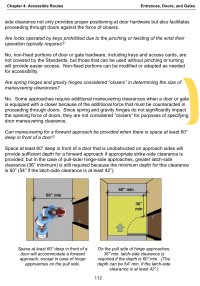-
Welcome to The Building Code Forum
Your premier resource for building code knowledge.
This forum remains free to the public thanks to the generous support of our Sawhorse Members and Corporate Sponsors. Their contributions help keep this community thriving and accessible.
Want enhanced access to expert discussions and exclusive features? Learn more about the benefits here.
Ready to upgrade? Log in and upgrade now.
You are using an out of date browser. It may not display this or other websites correctly.
You should upgrade or use an alternative browser.
You should upgrade or use an alternative browser.
ADA clearance side clearance next to a double-acting, self-closing traffic door without a mechanical closer.
- Thread starter Ryan Schultz
- Start date
- Featured
steveray
SAWHORSE
It does not have a latch so yes...
Yankee Chronicler
SAWHORSE
The 12-inch requirement applies if the door has a latch AND a closer. No latch ==> no requirement.
walker.t
SAWHORSE
You might not even have a closer…but the hinges are designed to 'close' the door
I don’t know where that clarification from the U.S. Access Board can be found. Only reference I could find in A117.1-2017 was in the commentary for 404.2.7.2 Spring Hinges: “Although not considered as a ‘door closer’ in the general sense, spring hinges…”.If you want the door to close, but don't want a closer, you can install spring hinges. The US Access Board has determined that spring hinges are not considered "closers" for the purpose of this issue.
If you need adjustable speed spring hinges, there's a brand called Waterson; they're not cheap, but they work well.
Yikes
SAWHORSE
I don’t know where that clarification from the U.S. Access Board can be found. Only reference I could find in A117.1-2017 was in the commentary for 404.2.7.2 Spring Hinges: “Although not considered as a ‘door closer’ in the general sense, spring hinges…”.
https://www.thebuildingcodeforum.com/forum/threads/elevator-shaft-rating.38062/post-303004
walker.t
SAWHORSE
Thank you.See this post and its link to the U.S. Access Board commentary.Can you point me to an exception in the ADA or A117.1 that says this? I understand that a spring hinge is not a closer like the devices mounted at the top of a door and frame, but considering that it exerts a force against the effort to open the door I would have thought it would be considered a closer for the sake of door maneuvering clearances.
See also pdf page 115 here: https://www.access-board.gov/files/ada/guides/ADA-Standards-Guide_Chapters1-5.pdf
Kind of funny (or sad) to see that this link leads to a post where you answered the same question asked by me before.
Yikes
SAWHORSE
Hey, I've done that tooKind of funny (or sad) to see that this link leads to a post where you answered the same question asked by me before.




